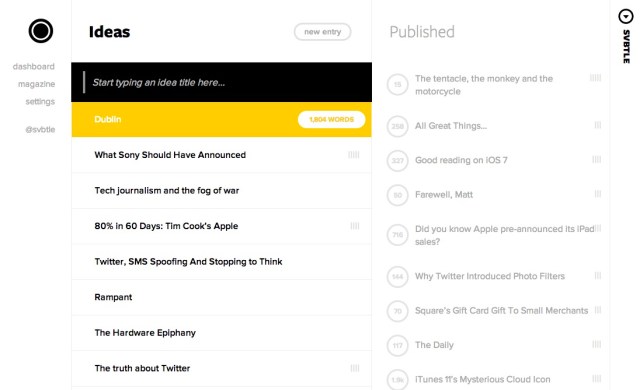I’m a pretty big fan of the way that Svbtle, a blogging platform from designer and developer Dustin Curtis, handles the creation and development of ideas.
Curtis rolled the lightweight publishing tool out to a select few users in its early days, and has been slowly expanding that over time. Today, the platform opens up to anyone who would like to register.
If you’re interested in a place to write that stays out of your way I highly encourage you to at least check out the free service. I’ve been a user for some time and I’ve become enamored with the way that it lets me jot down ideas and sit on them for a bit before I spool them out into something more interesting.

Over the past year, Curtis has been expanding Svbtle slowly. The project received funding last January and has since launched a responsive magazine that presents curated articles from the network’s contributors. Last year Curtis told us that the money was about building infrastructure and providing a “cushion for experimentation.”
The space that Svbtle occupies has gotten a bit more crowded these days with the ramp-up of Medium and other entrants. Offering people a low-barrier way to publish thoughts to the web has proved to be an interesting trend. At the very least, it’s offered us some unfiltered glimpses into the inner workings of the technorati, not all of them pleasant or well-advised.
Those lowered barriers have weakened the membrane between thought and publishing — in a similar way to what Twitter has done in the short form and what Tumblr has done for media. This democratization of design-driven publishing has put the emphasis on the content being shared, rather than what kind of template tweaker you are.
The ability to put words on the page (or images, as Svbtle supports a clever uploading method that allows you to just drag pictures right into the browser window) and see them exactly as they’ll be presented to the user is a more powerful mechanic than a lot of people give it credit for. Imagine being able to manipulate the text and images of a magazine article live on the page — seeing exactly how they’ll be presented to the next reader in real-time.
The standardization of the display and navigation of the site also allows the interface to fade into the background. Think of print magazines; they all work in exactly the same way in terms of ‘navigation’ and presentation of content. You flip pages, you look at stuff. The web is the polar opposite, with a mangled tapestry of navigation hierarchies and methodologies. Aside from the back button, we’re off in the weeds on the web.
This is one of the reasons I think that the app-driven navigation and reading experience has surged in popularity. It’s far from the only factor, but it’s a strong one. Having a comfortable, standardized navigation framework allows that interface to disappear and the content surge forward. It’s a problem a lot of smart people are working very hard to fix — and Svbtle is an interesting step in that direction.
Anyhow, just some thoughts about the platform. It’s free, you can tie it to your own domain, and it’s worth exploring.
Image Credit: Porsche Brosseau
